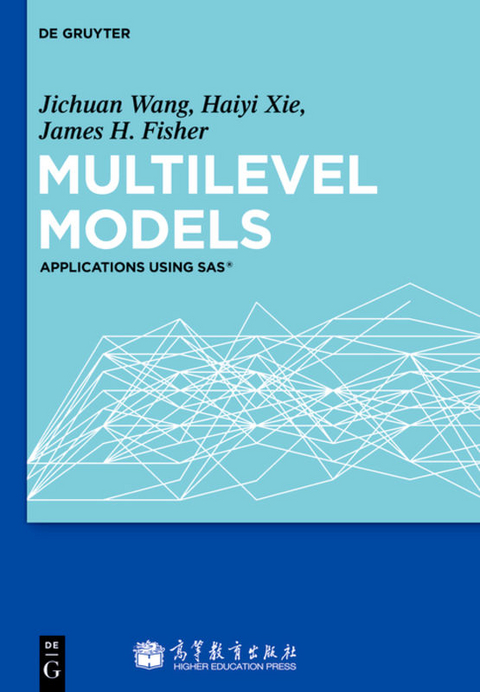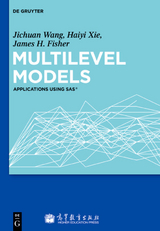Multilevel Models
De Gruyter (Verlag)
978-3-11-026759-4 (ISBN)
Jichuan Wang, Wright State University, Dayton, Ohio, USA; HaiyiXie, Dartmouth Medical School, Hanover, New Hampshire, USA; James H. Fisher, Wright State University, Dayton, Ohio, USA.
Preface
1 Introduction
1.1 Conceptual framework of multilevel modeling
1.2 Hierarchically structured data
1.3 Variables in multilevel data
1.4 Analytical problems with multilevel data
1.5 Advantages and limitations of multilevel modeling
1.6 Computer software for multilevel modeling
2 Basics of Linear Multilevel Models
2.1 Intraclass correlation coefficient (ICC)
2.2 Formulation of two-level multilevel models
2.3 Model assumptions
2.4 Fixed and random regression coefficients
2.5 Cross-level interactions
2.6 Measurement centering
2.7 Model estimation
2.8 Model fit, hypothesis testing, and model comparisons
2.8.1 Model fit
2.8.2 Hypothesis testing
2.8.3 Model comparisons
2.9 Explained level-1 and level-2 variances
2.10 Steps for building multilevel models
2.11 Higher-level multilevel models
3 Application of Two-level Linear Multilevel Models
3.1 Data
3.2 Empty model
3.3 Predicting between-group variation
3.4 Predicting within-group variation
3.5 Testing random level-1 slopes
3.6 Across-level interactions
3.7 Other issues in model development
4 Application of Multilevel Modeling to Longitudinal Data
4.1 Features of longitudinal data
4.2 Limitations of traditional approaches for modeling longitudinal data
4.3 Advantages of multilevel modeling for longitudinal data
4.4 Formulation of growth models
4.5 Data description and manipulation
4.6 Linear growth models
4.6.1 The shape of average outcome change over time
4.6.2 Random intercept growth models
4.6.3 Random intercept and slope growth models
4.6.4 Intercept and slope as outcomes
4.6.5 Controlling for individual background variables in models
4.6.6 Coding time score
4.6.7 Residual variance/covariance structures
4.6.8 Time-varying covariates
4.7 Curvilinear growth models
4.7.1 Polynomial growth model
4.7.2 Dealing with collinearity in higher order polynomial growth model
4.7.3 Piecewise (linear spline) growth model
5 Multilevel Models for Discrete Outcome Measures
5.1 Introduction to generalized linear mixed models
5.1.1 Generalized linear models
5.1.2 Generalized linear mixed models
5.2 SAS Procedures for multilevel modeling with discrete outcomes
5.3 Multilevel models for binary outcomes
5.3.1 Logistic regression models
5.3.2 Probit models
5.3.3 Unobserved latent variables and observed binary outcome measures
5.3.4 Multilevel logistic regression models
5.3.5 Application of multilevel logistic regression models
5.3.6 Application of multilevel logit models to longitudinal data
5.4 Multilevel models for ordinal outcomes
5.4.1 Cumulative logit models
5.4.2 Multilevel cumulative logit models
5.5 Multilevel models for nominal outcomes
5.5.1 Multinomial logit models
5.5.2 Multilevel multinomial logit models
5.5.3 Application of multilevel multinomial logit models
5.6 Multilevel models for count outcomes
5.6.1 Poisson regression models
5.6.2 Poisson regression with over-dispersion and a negative
binomial model
5.6.3 Multilevel Poisson and negative binomial models
5.6.4 Application of multilevel Poisson and negative binomial models
6 Other Applications of Multilevel Modeling and Related Issues
6.1 Multilevel zero-inflated models for count data with extra zeros
6.1.1 Fixed-effect ZIP model
6.1.2 Random effect zero-inflated Poisson (RE-ZIP) models
6.1.3 Random effect zero-inflated negative binomial (RE-ZINB) models
6.1.4 Application of RE-ZIP and RE-ZINB models
6.2 Mixed-effect mixed-distribution models for semi-continuous outcomes
6.2.1 Mixed-effects mixed distribution model
6.2.2 Application of the Mixed-Effect mixed distribution model
6.3 Bootstrap multilevel modeling
6.3.1 Nonparametric residual bootstrap multilevel modeling
6.3.2 Parametric residual bootstrap multilevel modeling
6.3.3 Application of nonparametric residual bootstrap multilevel modeling
6.4 Group-based models for longitudinal data analysis
6.4.1 Introduction to group-based model
6.4.2 Group-based logit model
6.4.3 Group-based zero-inflated Poisson (ZIP) model
6.4.4 Group-based censored normal models
6.5 Missing values issue
6.5.1 Missing data mechanisms and their implications
6.5.2 Handling missing data in longitudinal data analyses
6.6 Statistical power and sample size for multilevel modeling
6.6.1 Sample size estimation for two-level designs
6.6.2 Sample size estimation for longitudinal data analysis
Reference
Index
| Erscheint lt. Verlag | 23.12.2011 |
|---|---|
| Co-Autor | Higher Education Press |
| Zusatzinfo | 40 b/w ill. |
| Verlagsort | Berlin/Boston |
| Sprache | englisch |
| Maße | 170 x 240 mm |
| Gewicht | 600 g |
| Themenwelt | Informatik ► Datenbanken ► Data Warehouse / Data Mining |
| Mathematik / Informatik ► Mathematik ► Wahrscheinlichkeit / Kombinatorik | |
| Schlagworte | mehrstufig • Mehrstufiges Modell • Modell • Multilevel Model • Multilevel Model; SAS®; Statistics • Multilevel; Model; SAS®; Statistics • SAS • SAS® • Statistics • Statistik |
| ISBN-10 | 3-11-026759-4 / 3110267594 |
| ISBN-13 | 978-3-11-026759-4 / 9783110267594 |
| Zustand | Neuware |
| Haben Sie eine Frage zum Produkt? |
aus dem Bereich




